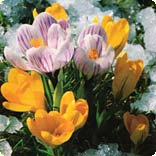Winter
Winter is the time when gardeners savor what is in store for them in the coming garden year. There will be new plants to try, new gardeners to meet, and
glorious adventures ahead. Make a fire, pour yourself a cup of hot chocolate, and look at photos of your past year’s garden. Note what the successes were and what you’ll do differently this year. Dream – use books and catalogues to inspire you.
Do you have a garden notebook? Many people jot a couple of notations each day about the sequence of their garden escapades, a couple lines this year compared to the couple of lines from last year and the year before serve as a personal dialogue about the garden. It’s fairly easy, and once a pattern of planting and growing emerges, nothing seems overwhelming. Remembering and anticipating seem to go hand in glove.
There are plants and seeds to order and new plots to plan. Planning includes thinking about bloom sequence, leaf texture, height requirements, and effective companion planting. What colors will you invite into the garden this year? What new plants? Seeds can be started — herbs first, then hardy vegetables, hardy annuals, and p
erennials. Tender annuals are not started until later, because they are only happy when transplanted into soil that is summer-warm. The comfortable sequence of seedlings breaking ground inside brings you closer and closer to being back in the garden again.
It’s difficult not to wander outside. Go ahead. It’s an ideal time to prune dead and unwanted limbs from dormant shade trees. Remove suckers and crossed limbs on the fruit trees, and prune summer flowering shrubs. Spring flowering shrubs will get their “haircut” later, right after they bloom.
By the end of winter, the bulbs will be pushing their way up. As you remove mulch, the smell of the earth will greet you. Birdcalls will beckon, and clouds scudding across a blue sky is the promise of wonderful weather to come. Carefully uncover the garden.
Spring

All the seedlings that you’ve been nurturing are ready for their debut in the garden. As you slide the new plants into place, give each a nutritious drink. New
plants and transplants rocket to sturdy, healthy growth with less stress and no burn.
Generations of farmers depend upon the trees and bushes to tell them when to plant. For instance, w
hen lilacs are in full bloom, they plant their beans and squash. Lettuce, peas, and spinach went in when those same lilacs were in first leaf. This practice is known as phenology — the science of when things appear. Hardy crops can go in when peach and plum trees are in bloom, and corn is planted when oak leaves are “the size of a mouse’s ear.” Perennials may be planted when maples are coming into leaf. It’s fun! Write in your notebook what goes on your property, for it may aid your planting in the future.
With most of the new additions planted and warmer weather wrapped around you, just visiting the burgeoning garden is fun. The reckless abandon with which plants bloom is amazing. There’s always a new discovery in the garden, and you’ll love the blossoms that will brighten your rooms every day.
All that plants require now is to be fed and watered. If you can manage it in the morning, there will be lots of time for them to absorb it all. Attach the Miracle-Gro® Garden Feeder to your hose or feeder wand, and both jobs can be accomplished at once. You can trust the results — strong roots, healthy plants, and bigger flowers and vegetables — and it couldn’t be easier. Some gardeners feed every time they water.
Summer
Gardens are on autopilot and doing their level best to please you in early summer. The flowers will stretch to their full height, color will run rampant through the yard, and you can sit back with a cool lemonade and enjoy it all. Pinch perennials, such as chrysanthemums and sedums, until the fourth of July. After that, let ’em rip. Feeding as you have been watering will be reflected in healthy, robust plants that stand the best chance of fighting off stressful visits by bugs. Most vegetables need one inch of water a week. Water! Water! Water! Don’t be surprised if verdant growth needs to be thinned out for good air circulation. This is your cue to gather flowers to your heart’s content, but let some flowers go to seed for production of next year’s seeds. Share your harvest, for you’re sure to be buried in bounty. “Isn’t it lovely!” is the often heard phrase now. Note in your garden book what you like best about the planting you have done.
Fall
Seed you’ve allowed to ripen nods in concert with the fruits and vegetables. Days become increasingly more golden. Fall is upon us all before we know it, and now is the time to plant spring-blooming bulbs. There’s a sequence to it. Begin with the lilies — they’re the tenderest — then tulips and daffodils.
Don’t forget the small bulbs. Many of them are the first to laugh off the snow, and others create great color combinations. As you tidy the beds for winter, you’ll be bursting with ideas for the next garden year based on current successes. Check notes you have made from your garden or those gardens that you have visited. Write what you especially loved about this year in your garden notebook. It will usually begin with “The joy of gardening!”